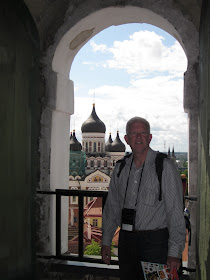It has been over six months since we returned from our trip to Russia and Scandinavia, and I still have a few more posts about Norway that I need to get up before I am finally done. In "The Old Days" we would gather our photos and notes and create a trip scrapbook, and the mess on the kitchen table would motivate me to get it done. You would think that the ease of using a computer would make digital scrapbooking a breeze, but as Martin Luther King noted, "All progress is precarious, and the solution of one problem brings us face to face with another problem." No mess = No impetus to finish.
Well, I always tell my fledgling student writers, "Don't tell me what you are going to write about, just write!" And so, back to Norway. Last July, I wrote a post about Oslo, the city and the churches, after the horrible shooting at a youth camp there. Now I am finally getting back to the many other beautiful sites of the city and the countryside.
One of my favorite places in Norway was Vigeland Sculpture Park. The park contains over 200 granite, wrought iron, and bronze sculptures of the various stages of human life, all of them created by one man: Gustav Vigeland, a Norwegian who lived from 1869-1943:
Vigeland is well known and much loved in Norway. Never heard of him? Chances are you have seen one of most famous works: The Nobel Peace Prize medal:
This ornate gate marks the entrance to the park:
A wide swath of neatly manicured lawn focuses all attention on the sculptures ahead:
It took Vigeland only twenty years to populate the park with his 212 sculptures. They are all nude and somewhat block-like, purposely lacking the muscle definition and proportion present in Renaissance sculpture carved hundreds of years before, and yet they somehow capture a great deal of movement and beautifully depict the rich emotions of everyday life.
In addition to these statues, there is a series of whimsical fountain sculptures with various figures playing in trees,
Around the base of the fountain are some wonderful friezes, again depicting different stages of life:
The most famous sculpture in the park is the 46-foot tall Monolith Totem, covered in 121 figures, all climbing towards the sky, a representation of man's reach for the spiritual and divine.
It took three stone carvers fourteen years to transfer the design from a plaster cast made by Vigeland to the stone. Vigeland died a year before its completion.
Well, I always tell my fledgling student writers, "Don't tell me what you are going to write about, just write!" And so, back to Norway. Last July, I wrote a post about Oslo, the city and the churches, after the horrible shooting at a youth camp there. Now I am finally getting back to the many other beautiful sites of the city and the countryside.
One of my favorite places in Norway was Vigeland Sculpture Park. The park contains over 200 granite, wrought iron, and bronze sculptures of the various stages of human life, all of them created by one man: Gustav Vigeland, a Norwegian who lived from 1869-1943:
Vigeland is well known and much loved in Norway. Never heard of him? Chances are you have seen one of most famous works: The Nobel Peace Prize medal:
This ornate gate marks the entrance to the park:
A wide swath of neatly manicured lawn focuses all attention on the sculptures ahead:
It took Vigeland only twenty years to populate the park with his 212 sculptures. They are all nude and somewhat block-like, purposely lacking the muscle definition and proportion present in Renaissance sculpture carved hundreds of years before, and yet they somehow capture a great deal of movement and beautifully depict the rich emotions of everyday life.
*Warning: By American standards, these are not G-rated sculptures.*
 |
| One of my favorites: an elderly father and his adult son. I loved the tender depictions of men. |
In addition to these statues, there is a series of whimsical fountain sculptures with various figures playing in trees,
Around the base of the fountain are some wonderful friezes, again depicting different stages of life:
 |
| Children coming to earth |
 |
| Death will separate even the most devoted of lovers |
 |
| Poignant sculpture of two old men |
 |
| If I had had a child with me, this pose would have been irrestible. |
It took three stone carvers fourteen years to transfer the design from a plaster cast made by Vigeland to the stone. Vigeland died a year before its completion.




















































































